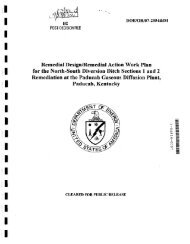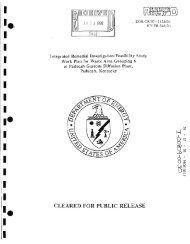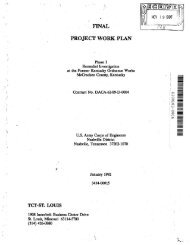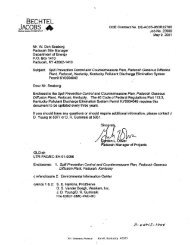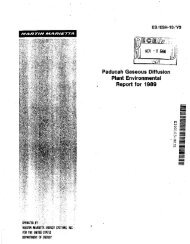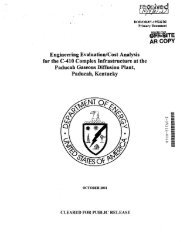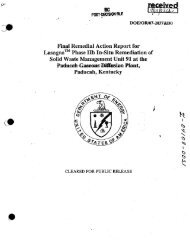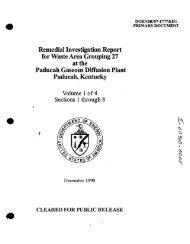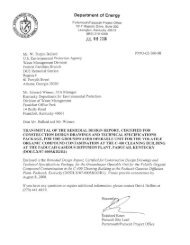1 - paducah environmental information center
1 - paducah environmental information center
1 - paducah environmental information center
Create successful ePaper yourself
Turn your PDF publications into a flip-book with our unique Google optimized e-Paper software.
Paducah Site<br />
discharges, whereas SS 28 is located in a similar<br />
type stream providing a regional reference site.<br />
present, are not significantly above background<br />
values.<br />
The Bayou and Little Bayou Creek<br />
downstream concentrations are higher than the<br />
background upstream concentrations for all<br />
uranium radionuclides. The uranium increase is<br />
attributed to plant operations. This is verified by<br />
the assay values (% 235U present) that are lower<br />
than would be seen for naturally occurring<br />
uranium (about 0.7% assay). These results<br />
concur with past studies in which uranium was<br />
detected. As shown in Table 5.5, total uranium<br />
concentrations in sediment in 1999 were not<br />
analyzed to a low enough level to be compared<br />
with past years~_<br />
The Little Bayou Creek downstream<br />
concentrations are higher than the background<br />
upstream concentration for 99'J'c. Table 5.6<br />
shows that 99'fc concentration in sediment at SS<br />
2 increased significantly in 1999, similar to the<br />
increase noted at SS 1 in 1998. Historical data<br />
collected in the past five years indicates that<br />
these increases at SS 2 and SS 1 may be<br />
anomalies because the value for 99'J'c is<br />
significantly higher than for the other years.<br />
Continued surveillance will prove or disprove<br />
this assumption. Other radionuclides, although<br />
Terrestrial Wildlife,<br />
Annual Deer Harvest<br />
In 1999, a total of eight deer were harvested<br />
in the WKWMA as part of DOE's ongoing effort<br />
to monitor the effects of the Paducah Site on the<br />
ecology of the surrounding area. Two deer<br />
obtained as background samples from the<br />
Ballard Wildlife Management Area (BWMA)<br />
were used for reference. Liver, muscle, and<br />
bone samples were analyzed for several<br />
radionuclides [I37CS, 237Np, 23 9 Pu, 99'J'c, 23%,<br />
234U, 235U, 238U, and 90Sr ~bonesamples only)].<br />
In addition, thyroid samples were analyzed for<br />
99'fc. Because the liver and muscle tissue. are<br />
considered consumable by hunters, these tissues<br />
can be evaluated for radiological risks (dose) if<br />
analyses reveal detectable levels above<br />
background, or reference, deer; Bone and<br />
thyroid saIIlples are used only as indicators of<br />
contamination. Table 5.7 lists deer with<br />
detectable levels of radionuclides;<br />
TableS.S Five-Year Uranium Concentrations in Sediment<br />
Total Uranium (JIg/g)<br />
1995 1996 1997 1998 1999<br />
UpstreamIReference Locations<br />
Bayou Creek<br />
SS 20 0.9 5.1 0.83 0.83 NO<br />
Little Bayou Creek<br />
SS 21 2.2 2.6 2.24 2.32 NO<br />
Massac Creek<br />
SS 28 0.51 1.8 0.31 0.33 NO<br />
Downstream Locations<br />
SS 1<br />
SS 2<br />
SS 27<br />
Bayou Creek<br />
2.97 3.5 2.59<br />
Little Bayou Creek<br />
12.5 43.5 21.3<br />
8.6 10.0 10.8<br />
60.1<br />
12.4<br />
2.18<br />
NO<br />
ND<br />
NO<br />
5-6<br />
Radiological Environmental Surveillance



